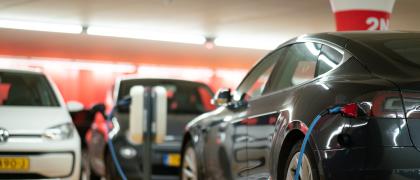
E-mobility explained simply: Smart Charging & Load Management
Intelligent solutions for efficient charging infrastructure
The spread of electric vehicles is increasing and along with them, the need for innovative charging solutions rises. Smart charging technologies are not only changing the way e-vehicles are supplied with electricity - they stand for the efficient use and distribution of energy and they ensure the stability of the power grid as well.
In this article, we bring you closer to the topic of smart charging and highlight some key components of dynamic load management.
Smart charging explained simply
Smart charging refers to technological approaches that are used to distribute electricity loads efficiently & according to demand, when electric vehicles get charged at charging stations. Data from the charging infrastructure, the vehicle and the charging network are recorded in real time and used to optimize charging processes and the distribution of power loads within the respective energy network.
Dynamic Load Management: Balancing Loads & Optimising Charges
One of the core components of Smart Charging is dynamic load management. Here's how it works: When you connect your electric vehicle to a charging station, a local controller communicates with the charging station as well as with an Energy Meter. The controller measures and controls the charging capacity of the charging station. The controller in turn measures the available charging capacity based on the data from the Energy Meter. This means that additional consumers, such as the building load, can also be taken into account.
If the local energy network is already heavily loaded, the charging capacity of the charging stations is reduced. Alternatively, charging processes can also be postponed to a later time when demand is lower. Dynamic load management not only prevents overloading of the electricity grid, but also ensures a stable and reliable energy supply for all users.
What are the advantages of smart charging & dynamic load management?
The integration of smart charging technologies results in numerous economic, ecological and energy-related advantages:
- Cost-efficient grid expansion: In addition to the positive connection assessment by distribution grid operators and associated cost optimizations, the investment costs for the expansion of the grid can be kept low and connection costs can be reduced.
- Grid-serving functionality: The optimized use of grid reserves and the avoidance of bottlenecks in the grid contribute to the stability of the whole electricity grid. In local energy networks, the avoidance of local overloads and peak shaving also ensure a stable supply and enable cost savings by lower grid provision fees.
- Energy distribution according to demand: Specific carging processes or individual charging points can be prioritised and served differently, depending on demand and taking into account other electrical consumers in the local network.
- Transparent data basis & processing: With the exact measurement of consumption values and the visualization of this data, new possibilities for optimizations are revealed and trust is created.
- Integration of sustainable infrastructure: With Smart Charging, the integration of energy from renewable sources gets simplified significantly, including their integration into stationary storage technologies. Self-generated electricity is used optimally & energy-efficiently - surplus energy from photovoltaic systems can be used for charging e-vehicles, for example.*
- Core technologies for future-proof mobility: Smart Charging plays a decisive role wherever the complex interplay between data & energy between the charging infrastructure and the power grid is involved - from generation and transmission to consumption & storage. This applies all the more to the future realization of innovative technologies such as vehicle-to-grid (V2G), vehicle-to-home (V2H) and other promising use cases.
*Please note that PV integrations for B2C customers must be implemented and operated by yourself. In regards to B2C customers of SMATRICS, our cooperation partners will support you.
Smart charging for sustainable mobility & stable energy grids
Smart charging and dynamic load management play a crucial role in the transition to a stable and sustainable energy ecosystem. Smart charging combines convenience for users with cost efficiency for charging infrastructure and grid operators.
Smart charging technologies pave the way for the further integration of renewable energy sources and open up the space for further innovation - the way we live mobility and operate our e-vehicles is thus increasingly determined by efficiency and sustainability.
Further information